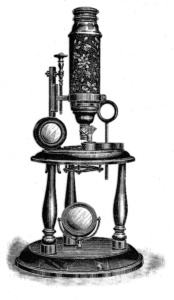MICROSCOPES: A HISTORY
Microscopes have a long and fascinating history, stretching back to the 17th century. The first known microscope was invented in the Netherlands in the late 16th century, but it was not until the 17th century that microscopes began to be used for scientific study.
ANTONIE VAN LEEUWENHOEK
One of the earliest and most famous microscopists was Antonie van Leeuwenhoek, a Dutch scientist who lived in the 17th century. Leeuwenhoek made his own microscopes, using glass beads to magnify objects. He discovered and documented many types of microorganisms, including bacteria, protozoa, and even sperm cells.
 |
 |
CARL ZEISS
In the 18th century, a number of scientists and instrument makers made important advances in microscope technology. One of the most important was Carl Zeiss, a German optician who founded a company that still produces high-quality microscopes today.

This microscope can be seen in the LMHM on display now
19TH CENTURY USE
The 19th century saw further improvements in microscope technology, as well as a growing recognition of the importance of microscopes in scientific research. Robert Koch, a German physician, used a microscope to study the bacteria that cause tuberculosis and cholera, and his work helped to establish the germ theory of disease.

This microscope can be seen in the LMHM on display now.
ELECTRON MICROSCOPES
In the 20th century, microscopes continued to be used in a wide range of scientific fields, from biology to materials science. Electron microscopes, which use beams of electrons instead of light to magnify objects, were developed in the mid-20th century and have become an important tool in many areas of research.
THE FUTURE
Today, microscopes continue to play a crucial role in scientific research, and new advances in technology are leading to even more powerful and versatile microscopes. From the humble glass bead microscope of the 17th century to the cutting-edge instruments of today, the history of microscopes is a testament to human ingenuity and the power of scientific curiosity.
 This microscope can be seen in the LMHM on display now. |
 |


